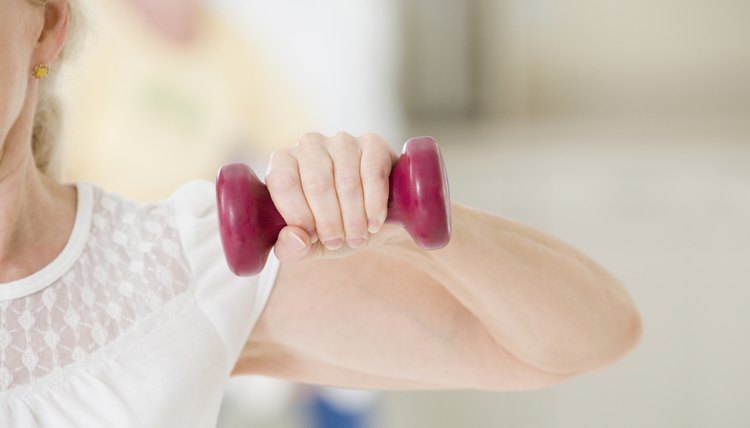Arm Exercises With Sternal Precautions

During open heart surgery, the breastbone, or sternum is cracked open to provide access for the doctors to get to your heart. Following the procedure, wires are used to sew the bone back together. During the initial healing process, patients have to be careful about splitting open the sternum through heavy lifting or inappropriate exercises. Sternal precautions are provided and must be followed for four to eight weeks.
Precautions
To avoid placing any stress on the sternum and possibly reopening the chest bone, you will incur more precautionary recommendations than active exercise guidelines. Exercises involving the arms can be particularly troublesome because you must not perform any movements that will place pressure on your chest. You'll be given a pillow to hold over your sternum by crossing your arms in front of your chest. You should press the pillow to hold the sternum in place when you sit or stand.
Weights
You should not lift any weight greater than 10 pounds during the first eight weeks of your recovery. Light weights of one-half or one pound are acceptable to keep your muscles active. While sitting, hold your pillow over your sternum with one arm and hold a light weight in your other hand, with your palm facing up. Bend your elbow and keep your arm close to your body for added support. Gently perform 10 bicep curls and rest. Lay the weight down while you switch arms and repeat 10 times on the other side.
Mobility
You must keep moving to avoid atrophy and stiffness. Walking is one of the most effective exercises that most heart patients are encouraged to pursue. Even short, 10-minute walks can help you to regain your previous level of endurance and promote flexibility. Before and after your walk you should sit in an armless chair and let your arms hang loose at your sides with your fingers pointed towards the floor. Raise one arm slowly until it is at shoulder level and hold for few seconds before lowering it back down. Maintain control while you lower your arm and don't let it drop as it could pull on your sternum. Breathe deeply and then repeat on the other arm. Alternate arms so that you exercise each side 10 times.
Full Stretching
One of the sternal precautions you must take for the first eight weeks is not to raise one arm above your head. The movement places undue pressure on one side of your chest and can disturb the wires holding your sternum together. You can however lift both arms at the same time. Raising your arms to full extension provides an effective stretch for both your arms and your core. While sitting upright in a chair or bed, slowly raise both arms in an arc until they are pointing to the ceiling. Hold for a count of five and slowly lower them. Repeat 10 times. Do not try to perform stretching arm raises while standing until you have regained your complete balance and do not rely on a walker for stability.
References
- Gkantsinikoudis N, Chaniotakis C, Gkasdaris G, Georgiou N, Kapetanakis S. Morphological approach of the sternal foramen: an anatomic study and a short review of the literature. Folia Morphol (Warsz). 2017;76(3):484-490. doi:10.5603/FM.a2017.0006
- Khoriati AA, Rajakulasingam R, Shah R. Sternal fractures and their management. J Emerg Trauma Shock. 2013;6(2):113-6. doi:10.4103/0974-2700.110763
- Anderson BW, Burns B. Anatomy, thorax, xiphoid process. Treasure Island, FL: StatPearls Publishing. Updated December 9, 2018.
- Proulx AM, Zyrd TW. Costochondritis: diagnosis and treatment. Am Fam Physician. 2009;80(6):617-620.
- Yoo WG. Effects of combined chest expansion and breathing exercises in a patient with sternal pain. J Phys Ther Sci. 2017;29(9):1706-1707. doi:10.1589/jpts.29.1706
- Ayloo A, Cvengros T, Marella S. Evaluation and treatment of musculoskeletal chest pain. Prim Care. 2013;40(4):863-87. doi:10.1016/j.pop.2013.08.007
- Singh K, Anderson E, Harper JG. Overview and management of sternal wound infection. Semin Plast Surg. 2011;25(1):25-33. doi:10.1055/s-0031-1275168
- El-Ansary D, Lapier TK, Adams J, et al. An evidence-based perspective on movement and activity following median sternotomy. Phys Ther. 2019. doi:10.1093/ptj/pzz126
Writer Bio
Linda Ray is an award-winning journalist with more than 20 years reporting experience. She's covered business for newspapers and magazines, including the "Greenville News," "Success Magazine" and "American City Business Journals." Ray holds a journalism degree and teaches writing, career development and an FDIC course called "Money Smart."
